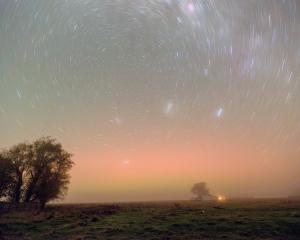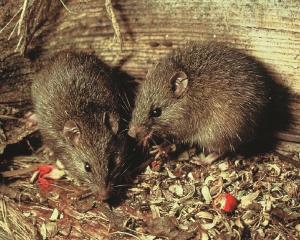Retired Otago Daily Times editor Robin Charteris and his wife, Judi, find fun and fury as they drive around Ireland.
After 38 hours of non-stop travel from Dunedin to Dublin, the lassitude of the long-distance traveller hung heavily upon us.
It was quickly dispelled by airport cabbie Gerard McGrath.
''Tirty-eight hours on the go!'' he exclaimed, as we headed for our hotel and sleep.
''Tat's so daft you must be Irish.''
We'd been in Ireland all of 30 minutes.
And this was our second brush with Irish humour, or is it realism? Earlier from the immigration official: ''First time in Ireland. Eh? You'll find all the terrible tings you've heard about Ireland are as true as true can be.''
They weren't, of course. But most of the good things we'd heard, though never yet encountered first-hand in almost half a century of world travel, turned out to be.
What is it about the Irish, Judi and I asked ourselves time after time on our two weeks touring the Republic of Ireland and Northern Ireland, that makes them such warm, friendly, fun-loving people?
After all, much of rural Ireland we encountered in 2000km of driving right around the combined coasts was hard and unforgiving: we found, as well as humour, a melancholy in land and people reminiscent of its harsh history.
Is the ubiquitous cheerfulness of the Irish a contrast to that history, perhaps, or because of it?
Everywhere was friendliness and welcome.
Shopkeepers, hotel staff, bus drivers, pub drinkers ... it seems an article of faith with the Irish that visitors be welcomed, advised, helped, offered, given, loved, cherished and charmed at every meeting.
Are there degree courses in warmth and hospitality, BAs in blarney perhaps?
(Tertiary qualifications, actually, are common here; 50% of Ireland's employees today have a university degree, compared with the European Union average of 29%, we learned.)
Even the elderly inspector on Dublin's inner-city tram displayed the ''full Irish'' when he caught us, just a day after our arrival, chancing our luck and riding without a ticket after we couldn't find the ticket machine.
''Oh, dear, well I couldn't see you both in clink, not on your first visit to our lovely Dublin now, could I?'' he smiled disarmingly as he took our fares, told us off and sent us on our chastened way.
It was just before that we had met Malachi, or he'd met us.
We'd popped into a pub for our first Dublin-brewed Guinness (4 million pints a day brewed here, lovely, too; smoother than at home) when he pulled up a chair. We learnt he was a lawyer, the youngest of 10 sons.
''After me, my parents gave up and adopted two girls''.
He and his French wife, a doctor, had five daughters under five - ''now that's Irish for you''.
He was having a drinks break while his mother babysat and his wife shopped for kiddies' clothes: ''We sure need plenty!''.
Chatty Malachi insisted on buying us another Guinness, so we had to reciprocate, of course, thus extending our 10-minute break to half a memorable afternoon.
Then we caught the tram, I think, and nearly found the Dublin clink.
Our purpose in visiting Ireland was to drive what Tourism Ireland, representing both countries, is touting as the Wild Atlantic Way, a coastal drive from Kinsale in the south around the bottom and up the west coast to Londonderry (Derry) in the north.
We went one better, including that route in a longer drive from Dublin clockwise around the coasts of both Irelands and back to Dublin again.
''Oh, and you'll be loving it all,'' our new mate Malachi had told us.
''And don't you miss calling in on my brothers in County Derry now. Have a pint with them.''
We did (love it all) and we didn't (have that particular pint), such were the attractions and distractions ahead.
Driving the Wild Atlantic Way was both breeze and battle.
It could be a huge drive - 2500km-plus if you followed every burp and bay of the rugged coastline - but by cutting a few corners and bypassing a peninsula or two it's a comfortable five or six days from bottom to top, averaging some 200km a day on a variety of excellent roads with comparatively little traffic. Around both Irelands is a doddle in 10-12 days though surely even better in 15 or 20.
We visited in shoulder-season October, so other tourists were few, roads were quiet and B&B accommodation plentiful and cheaper (average 75, or $NZ125 a night for two).
That was the breeze.
Our battle came with the weather, which changed from mild to malignant on day two as we headed for Kinsale, and stayed much that exciting way for the rest of the drive.
A blustery sou-wester roaring up the Celtic Sea, plus driving rain and barren hillocks looming out of shrouding fog, reminded us southern Kiwis of the drive from Colac Bay to Tuatapere.
It was Southland on steroids, quipped Judi.
For most of the next week we had our fill of howling wind and rain, huge Atlantic rollers on one side, a brooding, battered countryside on the other; and what indelible memories were created.
We had all that weather and scenery, a comfortable rental car, small towns and remote villages to visit, wonderful meals and accommodation to savour, plus the pleasure of the Irish people to boot.
Blarney Castle was an early highlight.
Climbing the 111 steps up the narrow, curving staircase of the 600-year-old tower took me to the famous stone and two lugubrious attendants.
They had me lie on my back and stretch out from the tower wall over a terrifyingly sheer drop to paving stones below.
I had to grasp two iron bars, push out further, twist my head uncomfortably backwards and kiss the large block of stone behind me.
''Don't fall now, man, will you,'' said one of the lugubrious as he held me.
''We'll lose our jobs if you do.''
Another gem was the spectacular Ring of Kerry, a long and winding coastal drive almost empty of tour buses at this time of year, punctuated by whitewashed cottages, small crofts and bare hills that reeked of history and harshness.
As in most of western rural Ireland, villages were far apart and small but the inhabitants warm and friendly.
Few houses here and elsewhere in western Ireland have gardens, we noted.
Grey slate and whitewash predominate, house walls are met by slate, gravel or concrete; fences and outbuildings are of utilitarian stone and slate.
Flowers and roses?
Not even in Tralee.
Further north were the impressive Cliffs of Moher, the huge and half-full carpark testimony to their tourism status, and then the strange limestone barrenness of the Burren.
Like most tourists, surely, we wanted to watch the sun go down on Galway Bay.
Instead, we got teeming rain, thunder, lightning and glowering clouds.
We could hardly see the road a hundred metres ahead let alone the famous bay.
The pub we found was good, though, with excellent Guinness and sausage and mash and lively companions.
Further up, in Donegal Bay (54 deg north now), we stopped at Killybegs, a fishing village now the deep-sea fishing centre for all Ireland and factory base for many huge European trawlers.
From our southwest-facing seaside hotel room we watched scampi and cod pouring from trawlers into huge wharfside containers - with a glorious 10pm sunset behind.
It was the one evening of lovely weather on our whole drive.
Even so, ''As you watch the sun go down on Donegal Bay'' didn't have quite the same musical ring about it.
Crossing into Northern Ireland revealed mile after mile of Irish peat bogs and barren, rugged mountains, empty and bare like the Highlands of Scotland, impressive in the same brooding and lonely manner.
Just a blackboard-type sign told us we'd crossed the border.
Later, petrol stations showed prices in Irish pounds rather than Euros, so we knew we were close to Derry, the end (or start) point of the Wild Atlantic Way.
This historic city is among the best of the gems of Ireland, we found.
Its magnificent old Guildhall and solid city walls are still intact; from the walls one can look down on the Bogside, scene of so many of the ''Troubles'' of last century between Catholics and Protestants, and wonder at the hell and hatred of it all, now thankfully in the past.
Belfast was big and sprawling, too busy for us elderly travellers, but the northern coastal drive to get there from Derry quite outstanding.
Huge waves and white foam battered the Giant's Causeway so brutally the world heritage site was closed to the public; all along the bays and cliffs of the coast furious winds and seas whipped up a maelstrom, yet tiny fishing harbours and treeless hamlets testified to the hardiness of local fisherfolk and crofters.
The run due south from here to Dublin was faster by motorway, though local roads - tarsealed, of course, as are all in Ireland - weave in and out along the coastline.
The rural landscape here is more akin to English countryside than is that of the Irish Republic, with hedgerows, trees and houses with gardens, but there is not the softness and chocolate-box prettiness of much of England.
Through all this fortnight of exploring the ancient lands of the Irish Republic and Northern Ireland was the welcome presence of the ultra-friendly Irish themselves.
Little questions niggled.
Are the southerners perhaps a little more laid-back and relaxed than those of the north?
Is there really any difference?
What about religious divisions?
Are they still there?
Hard to say.
What all the Irish do have in common, in spades, is faith, hope, charity ... and humour.
Take our problem on our last driving day, as we searched for the amazing Stone Age funereal site of Newgrange, just north of Dublin.
Despite the use of a GPS in our car, we were lost.
We were close but road signs were frustrating, so we stopped at a small farmhouse.
A middle-aged woman inside seated at a spinning wheel smiled as I knocked and entered.
''Excuse me, but I'm lost,'' I said.
''I know Newgrange is here somewhere but I can't seem to find it.''
''Tsk, you're never lost in Ireland, my love,'' she replied.
''You're just not there yet.''













